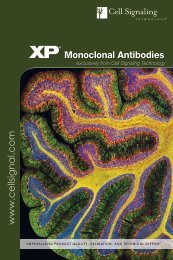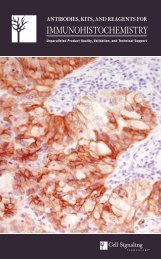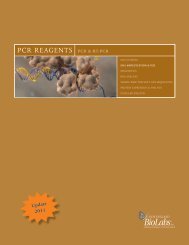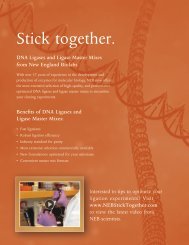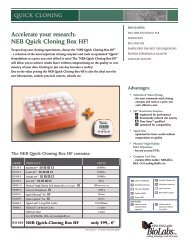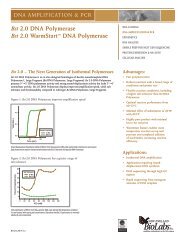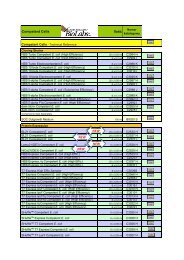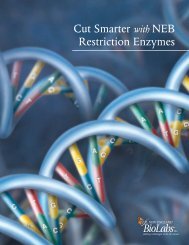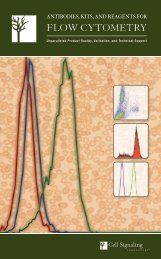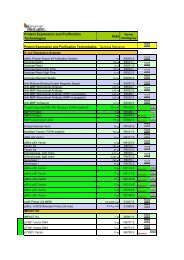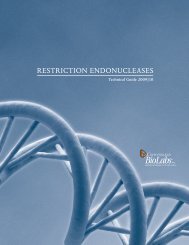2011 Apop.pdf - Lab-JOT
2011 Apop.pdf - Lab-JOT
2011 Apop.pdf - Lab-JOT
You also want an ePaper? Increase the reach of your titles
YUMPU automatically turns print PDFs into web optimized ePapers that Google loves.
Bcl-2 Family Members<br />
Bim Antibody #2819: Confocal IF analysis<br />
of HeLa cells using #2819 (green). Actin<br />
filaments were labeled with Alexa Fluor ® 555<br />
phalloidin (red). Blue pseudocolor = DRAQ5 ®<br />
#4084 (fluorescent DNA dye).<br />
Phospho-Bcl-2<br />
(Ser70) (5H2)<br />
Rabbit mAb<br />
#2827: WB<br />
analysis of extracts<br />
from Jurkat cells,<br />
untreated or treated<br />
with paclitaxel<br />
(1 μM, overnight)<br />
and with or without<br />
λ phosphatase (A),<br />
using #2827. Flow<br />
cytometric analysis<br />
of Jurkat cells (B)<br />
using #2827, versus<br />
propidium iodide<br />
(DNA content).<br />
A<br />
kDa<br />
200<br />
140<br />
100<br />
80<br />
60<br />
50<br />
40<br />
30<br />
20<br />
200<br />
140<br />
100<br />
80<br />
60<br />
50<br />
40<br />
30<br />
20<br />
–<br />
– – + + +<br />
Phospho-<br />
Bcl-2<br />
Bcl-2<br />
Paclitaxel<br />
λ phosphatase<br />
Bcl-xL (54H6) Rabbit mAb #2764: IHC analysis of paraffin-embedded human colon carcinoma using<br />
#2764 in the presence of control peptide (left) or Bcl-xL Blocking Peptide #1225 (right).<br />
Bax (D2E11) Rabbit mAb #5023: IHC analysis of paraffin-embedded human breast carcinoma using<br />
#5023 in the presence of control peptide (left) or antigen-specific peptide (right).<br />
Phospho-Bcl-2 (Ser70)<br />
10 3<br />
10 2<br />
10 1<br />
10 0 0<br />
DNA (PI)<br />
1023<br />
B<br />
Applications Reactivity<br />
#4647 A1/Bfl-1 Antibody W, IP H, (M, R)<br />
#5284 Phospho-Bad (Ser112) (40A9) Rabbit mAb W, IHC-P, F H, M, R, Mk<br />
#9291 Phospho-Bad (Ser112) Antibody W, IP, F, E-P H, M, R, Mk<br />
#9296 Phospho-Bad (Ser112) (7E11) Mouse mAb W H, M, R, Mk<br />
New #4366 Phospho-Bad (Ser136) (D25H8) Rabbit mAb W, IP H, M, Mk, (R)<br />
#5286 Phospho-Bad (Ser136) (185D10) Rabbit mAb W M, Mk, (H, R)<br />
#9295 Phospho-Bad (Ser136) Antibody W M, (H, R)<br />
#9297 Phospho-Bad (Ser155) Antibody W, E-P H, M<br />
#9239 Bad (D24A9) Rabbit mAb W H, M, R, Mk<br />
#9268 Bad (11E3) Rabbit mAb (IP Preferred) W, IP H, M, R, (Mk)<br />
#9292 Bad Antibody W, IP H, M, R, Mk<br />
#3814 Bak Antibody W H, M, R, Mk<br />
New #5023 Bax (D2E11) Rabbit mAb W, IP, IHC-P H<br />
#2772 Bax Antibody W, IP H, M, R, Mk<br />
#2774 Bax Antibody (Human Specific) W, IP, IHC-P H, Mk<br />
#2875 Phospho-Bcl-2 (Thr56) Antibody<br />
W<br />
H<br />
(Human Specific)<br />
#2827 Phospho-Bcl-2 (Ser70) (5H2) Rabbit mAb W, IF-IC, F H<br />
#2834 Phospho-Bcl-2 (Ser70) (5H2) Rabbit mAb F<br />
H<br />
(Alexa Fluor ® 488 Conjugate)<br />
#4223 Bcl-2 (D55G8) Rabbit mAb<br />
W, IP H<br />
(Human Specific)<br />
#3498 Bcl-2 (D17C4) Rabbit mAb<br />
W, IP H, M<br />
(Mouse Preferred)<br />
#2870 Bcl-2 (50E3) Rabbit mAb W, IP H, M, R, (Mk, C,<br />
B, Dg)<br />
#2876 Bcl-2 Antibody W H, M, R<br />
#2872 Bcl-2 Antibody (Human Specific) W H<br />
#3869 BCL2L10 Antibody W H, M, R, Mk<br />
#2724 Bcl-w (31H4) Rabbit mAb W H, M, R<br />
#2764 Bcl-xL (54H6) Rabbit mAb W, IP, IHC-P, IHC- H, M, R, Mk<br />
F, IF-IC<br />
#2767 Bcl-xL (54H6) Rabbit mAb<br />
F<br />
H, M, R<br />
(Alexa Fluor ® 488 Conjugate)<br />
#2762 Bcl-xL Antibody W, IP, IHC-P H, M, R, Mk<br />
#2002 BID Antibody (Human Specific) W, IP H<br />
#2003 BID Antibody (Mouse Specific) W M<br />
#2006 BID (7A3) Mouse mAb (Human Specific) W H<br />
#4592 Bik Antibody W, IHC-P H<br />
#4550 Phospho-Bim (Ser55) Antibody W M, (H, R)<br />
#4585 Phospho-Bim (Ser69) (D7E11) Rabbit mAb W, IP H, M, (R, Mk, Dg)<br />
#4581 Phospho-Bim (Ser69) Antibody W, IP H, M, (R, Mk, Dg)<br />
#2933 Bim (C34C5) Rabbit mAb W, IP, IHC-P,<br />
IF-IC, F<br />
H, M, R,<br />
(Mk, B, Dg)<br />
#2819 Bim Antibody W, IP, IF-IC, F H, M, R, (Mk)<br />
#3769 BNIP3 Antibody (Rodent Specific) W M, R<br />
#4521 Bok Antibody W H, M, R, Mk<br />
#4579 Phospho-Mcl-1 (Ser159/Thr163) Antibody W, IP H<br />
New #5453 Mcl-1 (D35A5) Rabbit mAb W H, M, (Mk, B)<br />
#4572 Mcl-1 Antibody W H<br />
#4976 Puma Antibody W H, (Mk)<br />
Phospho-Bad (Ser136) (D25H8) Rabbit mAb<br />
#4366: WB analysis of extracts from COS-7 cells,<br />
treated with hEGF #8916 (100 ng/ml, 30 min.) in<br />
the presence or absence of l phosphatase and calf<br />
intestinal phosphatase (CIP), using #4366.<br />
Mcl-1 (D35A5) Rabbit<br />
mAb #5453: WB analysis<br />
of extracts from 293T<br />
cells, mock transfected or<br />
transfected with human or<br />
mouse Mcl-1 constructs (A),<br />
using #5453. WB analysis<br />
of extracts from various cell<br />
lines (B) using #5453.<br />
kDa<br />
200<br />
140<br />
100<br />
80<br />
60<br />
50<br />
40<br />
30<br />
Selected Application References:<br />
Phospho-Bad (Ser112) Antibody #9291:<br />
Gray, M.J. et al. (2008) J. Natl Cancer Inst.<br />
100, 109–120. (W) / Fujita, H. et al. (2005)<br />
Biochem. Pharmacol. 69, 1773–1784. (W) /<br />
Jamieson, C.A. and Yamamoto, K.R. (2000)<br />
Proc. Natl. Acad. Sci. USA 97, 7319–7324.<br />
(W) / Bertolotto, C. et al. (2000) J. Biol. Chem.<br />
275, 37246–37250. (W) / Tan, Y. et al. (1999) J.<br />
Biol. Chem. 274, 34859–34867. (W)<br />
Phospho-Bad (Ser112) (7E11) Mouse<br />
mAb #9296: Avota, E. et al. (2001) Nat. Med.<br />
7, 725–731. (W) / Bieberich, E. et al. (2001) J.<br />
Biol. Chem. 276, 44396–44404. (W)<br />
Phospho-Bad (Ser136) Antibody #9295:<br />
Gray, M.J. et al. (2008) J. Natl. Cancer Inst.<br />
100, 109–120. (W) / Fujita, H. et al. (2005)<br />
Biochem. Pharmacol. 69, 1773–1784. (W) /<br />
Rusiñol, A.E. et al. (2004) J. Biol. Chem. 279,<br />
1392–1399. (W) / Yang, C–C. et al. (2003) J.<br />
Biol. Chem. 278, 25872–25878. (W)<br />
Phospho-Bad (Ser155) Antibody<br />
#9297: Saito, A. et al. (2003) J. Neurosci. 23,<br />
1710–1718. (W) / Yusta, B. et al. (2002) J. Biol.<br />
Chem. 277, 24896–24906. (W) / Tan, Y. et al.<br />
(2000) J. Biol. Chem. 275, 25865–25869. (W)<br />
Bad Antibody #9292: Gray, M.J. et al. (2008)<br />
J. Natl. Cancer Inst. 100, 109–120. (W) / Liu,<br />
C. et al. (2003) Cancer Res. 63, 3138–3144.<br />
(W, IP) / Saito, A. et al. (2003) J. Neurosci. 23,<br />
1710–1718. (W) / Yu, C. et al. (2003) Cancer<br />
Res. 63, 1822–1833. (W)<br />
A<br />
20<br />
10<br />
kDa<br />
80<br />
60<br />
50<br />
40<br />
30<br />
20<br />
80<br />
60<br />
50<br />
40<br />
30<br />
20<br />
human<br />
Mcl-1<br />
mouse<br />
Mcl-1<br />
– + – hMcl-1<br />
– – + mMcl-1<br />
Phospho-<br />
Bad<br />
Bad<br />
– + CIP + λ phosphatase<br />
B<br />
kDa<br />
200<br />
140<br />
100<br />
80<br />
60<br />
50<br />
40<br />
30<br />
20<br />
10<br />
Raji<br />
SR<br />
OVCAR8<br />
A20<br />
human<br />
Mcl-1<br />
mouse<br />
Mcl-1<br />
Bax Antibody #2772: Yang, L. et al. (2004)<br />
J. Biol. Chem. 279, 11639–11648. (W) /<br />
Rusiñol, A.E. et al. (2004) J. Biol. Chem. 279,<br />
1392–1399. (W) / Leu, J. et al. (2004) Nat. Cell<br />
Biol. 6, 443–450. (W, IP) / Cheong, J-W. et al.<br />
(2003) Clin. Cancer Res. 9, 5018–5027. (W)<br />
Bcl-2 Antibody #2876: Yang, Y.M. et al.<br />
(2005) Cancer Res. 65, 8538–8547. (W) /<br />
Yang, L. et al. (2004) J. Biol. Chem. 279,<br />
11639–11648. (W)<br />
Bcl-2 Antibody (Human Specific) #2872:<br />
Samanta, A.K. et al. (2004) J. Biol. Chem. 279,<br />
7576–7583. (W)<br />
Bcl-xL Antibody #2762: Leu, J. et al. (2004)<br />
Nat. Cell Biol. 6, 443–450. (W, IP) / Saito, A.<br />
et al. (2003) J. Neurosci. 23, 1710–1718. (W,<br />
IHC) / Yang, C-C. et al. (2003) J. Biol. Chem.<br />
278, 25872–25878. (W)<br />
BID Antibody (Human Specific) #2002:<br />
Ogino, T. et al. (2009) Leuk. Res. 33, 151–158.<br />
(W) / Abdelrahim, M. et al. (2006) Carcinogenesis<br />
27, 717–728. (W) / Weng, C. et al.<br />
(2005) J. Biol. Chem. 280, 10491–10500.<br />
(W) / Chandrasekar, B. et al. (2004) J. Biol.<br />
Chem. 279, 20221–20233. (W)<br />
Mcl-1 Antibody #4572: Ocio, E.M. et al.<br />
(2009) Blood 113, 3781–3791. (W) / Roccaro,<br />
A.M. et al. (2008) Clin. Cancer Res. 14,<br />
1849–58. (W) / Roccaro, A.M. et al. (2008)<br />
Blood 111, 4752–4763. (W) / Kashkar, H.<br />
et al. (2007) Blood 109, 3982–3988. (W) /<br />
Gulmann, C. et al. (2005) Clin. Cancer Res. 11,<br />
5847–5855. (W)<br />
Please visit www.cellsignal.com for a complete product listing.<br />
SignalSilence ® siRNA<br />
Kits and Reagents<br />
SignalSilence ® siRNA duplexes from Cell Signaling Technology (CST) allow the<br />
researcher to specifically inhibit protein expression. These products utilize RNA<br />
interference, a method in which gene expression can be selectively silenced through<br />
the delivery of double stranded RNA molecules into the cell. Two siRNAs are now<br />
available for most targets (siRNA I and II). A fluorescein-labeled non-targeted siRNA<br />
control allows the user to monitor transfection efficiency. In addition, an unconjugated<br />
control siRNA can be used to control for specific protein inhibition.<br />
• siRNA duplexes are designed, produced, and purified<br />
in-house – siRNA products are held to the same stringent<br />
quality control standards as CST antibody products.<br />
• siRNA duplexes offered are used in-house for antibody<br />
validation – effective knockdown is assessed by scientists<br />
at Cell Signaling Technology at the protein level.<br />
• Technical support is provided by the same scientists who<br />
produce and validate the products – you have access to<br />
our knowledgeable technical support scientists to discuss<br />
transfection methods or any other questions.<br />
Targets I II<br />
Atg4B New #6336 –<br />
Atg4C New #6325 –<br />
Atg5 New #6345 –<br />
Atg7 New #6604 –<br />
Atg14 New #6286 #6287<br />
Bad #6471 #6512<br />
Bax #6321 #6514<br />
Bcl-2 #6441 #6516<br />
Bcl-xL New #6362 #6363<br />
Beclin-1 New #6222 #6246<br />
Bim #6461 #6518<br />
Caspase-3 #6466 #6520<br />
Caspase-10 New #6357 –<br />
LC3A New #6214 #6215<br />
LC3B New #6212 #6213<br />
Mcl-1 New #6315 –<br />
c-Myc #6341 #6552<br />
NDRG1 New #6245 #6257<br />
NF-kB p65 #6261 #6534<br />
p53 #6231 #6562<br />
PARP New #6304 #6305<br />
Survivin #6351 #6546<br />
XIAP #6446 #6550<br />
Control (Unconjugated) #6568 –<br />
Control (Fluorescein Conjugate) #6201 –<br />
kDa<br />
140<br />
100<br />
80<br />
60<br />
50<br />
40<br />
30<br />
20<br />
60<br />
50<br />
I<br />
Bcl-xL<br />
α-Tubulin<br />
SignalSilence ® Bcl-xL<br />
siRNA I #6362 and siRNA II<br />
#6363: WB analysis of extracts<br />
from HeLa cells, transfected<br />
with 100 nM SignalSilence ®<br />
Control siRNA (Unconjugated)<br />
#6568 (-), #6362 (+), or #6363<br />
(+), using Bcl-xL (54H6)<br />
Rabbit mAb #2764 (upper)<br />
or α-Tubulin (11H10) Rabbit<br />
mAb #2125 (lower). The Bcl-xL<br />
(54H6) Rabbit mAb confirms<br />
silencing of Bcl-xL expression,<br />
while the α-Tubulin (11H10)<br />
Rabbit mAb is used as a loading<br />
control.<br />
II<br />
– + +<br />
Visit our website for a complete listing of SignalSilence ® siRNA products.<br />
Bcl-xL siRNA<br />
10<br />
Applications Key:<br />
W Western / IP Immunoprecipitation / IHC Immunohistochemistry / IF Immunofluorescence / F Flow Cytometry / ChIP Chromatin Immunoprecipitation / (-IC Immunocytochemistry, -P Paraffin, -F Frozen) / E-P Peptide ELISA<br />
Reactivity Key:<br />
H human / M mouse / R rat / Hm hamster / Mk monkey / C chicken / Mi mink / Dm D. melanogaster / X Xenopus / Z zebra fish / B bovine / Dg dog / Pg pig / Sc S. cerevisiae / All all species expected / ( ) 100% sequence homology<br />
11



